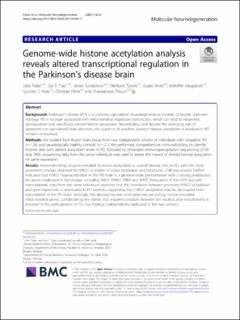| dc.contributor.author | Toker, Lilah | |
| dc.contributor.author | Tran, Gia T. | |
| dc.contributor.author | Sundaresan, Janani | |
| dc.contributor.author | Tysnes, Ole-Bjørn | |
| dc.contributor.author | Alves, Guido | |
| dc.contributor.author | Haugarvoll, Kristoffer | |
| dc.contributor.author | Nido, Gonzalo S. | |
| dc.contributor.author | Dölle, Christian | |
| dc.contributor.author | Tzoulis, Charalampos | |
| dc.date.accessioned | 2022-12-29T13:13:01Z | |
| dc.date.available | 2022-12-29T13:13:01Z | |
| dc.date.created | 2021-07-09T18:51:10Z | |
| dc.date.issued | 2021-05 | |
| dc.identifier.citation | Toker, L., Tran, G.T., Sundaresan, J. et al. (2021) Genome-wide histone acetylation analysis reveals altered transcriptional regulation in the Parkinson’s disease brain. Molecular Neurodegeneration, 16 (1), 31 | en_US |
| dc.identifier.issn | 1750-1326 | |
| dc.identifier.uri | https://hdl.handle.net/11250/3039897 | |
| dc.description.abstract | Background
Parkinson’s disease (PD) is a complex, age-related neurodegenerative disorder of largely unknown etiology. PD is strongly associated with mitochondrial respiratory dysfunction, which can lead to epigenetic dysregulation and specifically altered histone acetylation. Nevertheless, and despite the emerging role of epigenetics in age-related brain disorders, the question of whether aberrant histone acetylation is involved in PD remains unresolved.
Methods
We studied fresh-frozen brain tissue from two independent cohorts of individuals with idiopathic PD (n = 28) and neurologically healthy controls (n = 21). We performed comprehensive immunoblotting to identify histone sites with altered acetylation levels in PD, followed by chromatin immunoprecipitation sequencing (ChIP-seq). RNA sequencing data from the same individuals was used to assess the impact of altered histone acetylation on gene expression.
Results
Immunoblotting analyses revealed increased acetylation at several histone sites in PD, with the most prominent change observed for H3K27, a marker of active promoters and enhancers. ChIP-seq analysis further indicated that H3K27 hyperacetylation in the PD brain is a genome-wide phenomenon with a strong predilection for genes implicated in the disease, including SNCA, PARK7, PRKN and MAPT. Integration of the ChIP-seq with transcriptomic data from the same individuals revealed that the correlation between promoter H3K27 acetylation and gene expression is attenuated in PD patients, suggesting that H3K27 acetylation may be decoupled from transcription in the PD brain. Strikingly, this decoupling was most pronounced among nuclear-encoded mitochondrial genes, corroborating the notion that impaired crosstalk between the nucleus and mitochondria is involved in the pathogenesis of PD. Our findings independently replicated in the two cohorts.
Conclusions
Our findings strongly suggest that aberrant histone acetylation and altered transcriptional regulation are involved in the pathophysiology of PD. We demonstrate that PD-associated genes are particularly prone to epigenetic dysregulation and identify novel epigenetic signatures associated with the disease. | en_US |
| dc.language.iso | eng | en_US |
| dc.publisher | BioMed Central | en_US |
| dc.rights | Navngivelse 4.0 Internasjonal | * |
| dc.rights.uri | http://creativecommons.org/licenses/by/4.0/deed.no | * |
| dc.subject | nevrologi | en_US |
| dc.subject | Parkinson | en_US |
| dc.title | Genome-wide histone acetylation analysis reveals altered transcriptional regulation in the Parkinson’s disease brain | en_US |
| dc.type | Peer reviewed | en_US |
| dc.type | Journal article | en_US |
| dc.description.version | publishedVersion | en_US |
| dc.rights.holder | © 2021, The Author(s) | en_US |
| dc.subject.nsi | VDP::Medisinske Fag: 700::Klinisk medisinske fag: 750::Nevrologi: 752 | en_US |
| dc.source.pagenumber | 1-20 | en_US |
| dc.source.volume | 16 | en_US |
| dc.source.journal | Molecular Neurodegeneration | en_US |
| dc.source.issue | 1 | en_US |
| dc.identifier.doi | 10.1186/s13024-021-00450-7 | |
| dc.identifier.cristin | 1921257 | |
| dc.source.articlenumber | 31 (2021) | en_US |
| cristin.ispublished | true | |
| cristin.fulltext | original | |
| cristin.qualitycode | 1 | |

